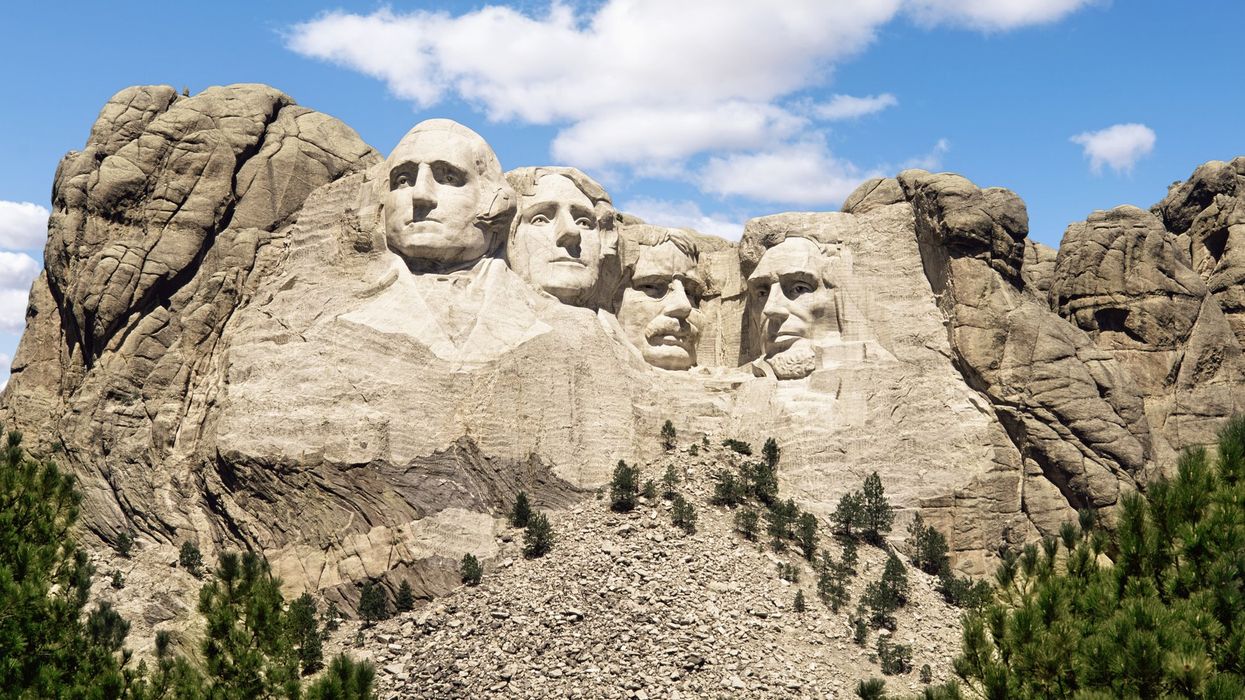The Fulcrum introduces Congress Bill Spotlight, a weekly report by Jesse Rifkin, focusing on the noteworthy legislation of the thousands introduced in Congress. Rifkin has written about Congress for years, and now he's dissecting the most interesting bills you need to know about, but that often don't get the right news coverage.
“You must not know Trump very well,” comedian Seth Meyers quipped, “if you expect him to share a mountain with four other guys.”
The Bill
A bill in Congress would carve President Donald Trump’s face into Mount Rushmore alongside George Washington, Thomas Jefferson, Abraham Lincoln, and Theodore Roosevelt.
According to the legislative text, Trump’s face would be added, rather than replacing an existing one. It also doesn’t specify where exactly Trump’s face would go; surely the middle is a logistical impossibility, so presumably, it would either be to Washington’s left or Lincoln’s right.
The House bill was introduced on January 28 by Rep. Anna Paulina Luna (R-FL13). The bill does not appear to have a title. No Senate companion version appears to have been introduced yet.
Context
Sculpted by Gutzon Borglum and completed in 1941, the South Dakota monument stands among America’s most iconic landmarks. The facade depicts the giant faces of four presidents whom a 2021 C-SPAN presidential historians survey ranked #1 (Lincoln), #2 (Washington), #4 (Roosevelt), and #7 (Jefferson).
The site notched 2.3 million visitors in 2023, the last year for which statistics are available. On Independence Day in 2020, Trump attended a fireworks display and delivered a speech at the site, after which South Dakota’s then-Gov. Kristi Noem presented him with a figurine depicting Trump’s face added to the mountain. (Noem is now Trump’s Secretary of Homeland Security.)
While the present was a joke, the idea was serious enough for South Dakota’s at-large Rep. Dusty Johnson (R-SD) to introduce the Mount Rushmore Protection Act. The bill would have prevented the monument’s alteration in any significant way, whether it’s adding a face like Trump’s or removing a face, as there were calls to remove Washington and Jefferson for owning slaves.
The bill attracted 38 cosponsors but never received a committee vote. Rep. Johnson subsequently introduced the bill in 2022 and 2023, with the 2023 version even receiving a hearing before the House Natural Resource Committee’s Subcommittee on Federal Lands. Still, no version has received a vote.
What Supporters Say
Supporters argue that Trump has merited his place alongside the four depicted presidents.
“President Trump’s bold leadership and steadfast dedication to America’s greatness have cemented his place in history,” Rep. Luna said in a press release. “Mount Rushmore, a timeless symbol of our nation’s freedom and strength, deserves to reflect his towering legacy — a legacy further solidified by the powerful start to his second term.”
Needless to say, one other likely supporter is the president himself.
The New York Times reported that White House aides contacted the South Dakota governor’s office in 2020, inquiring about the process for potentially adding one or more faces to the monument. Trump disputed the report but added, “Although, based on all of the many things accomplished during the first 3½ years, perhaps more than any other presidency, sounds like a good idea to me!”
What Opponents Say
Obviously, Democrats oppose the bill because they don’t want to memorialize Trump in that way. But some Republicans may oppose the bill too.
One potential Republican line of opposition could be that Trump is still alive. When Mount Rushmore was unveiled, all four depicted presidents had already died, the last being Roosevelt in 1919. For a similar reason, U.S. postal stamps can only depict people who died at least three years prior.
Another Republican line of argument: the monument is finished, as is. “In more than one instance, there have been discussions – whether serious or joking – about adding someone’s face to Mount Rushmore. In every instance, these proposals have been rejected,” South Dakota’s state Sen. Helene Duhamel (R) testified before Congress. “It is a complete work of art, displayed for the ages.”
Finally: logistics. “The rock that surrounds the sculpted faces is not suitable for additional carving,” Mount Rushmore’s Chief of Interpretation and Education Maureen McGee-Ballinger told a South Dakota newspaper, the Sioux Falls Argus Leader.
Odds of Passage
The bill has attracted zero cosponsors so far, not even any Republicans. It awaits a potential vote in the House Natural Resources Committee, controlled by Republicans.
Jesse Rifkin is a freelance journalist with the Fulcrum. Don’t miss his weekly report, Congress Bill Spotlight, every Friday on the Fulcrum. Rifkin’s writings about politics and Congress have been published in the Washington Post, Politico, Roll Call, Los Angeles Times, CNN Opinion, GovTrack, and USA Today.SUGGESTIONS:
Congress Bill Spotlight: Panama Canal Repurchase Act
Congress Bill Spotlight: Make Greenland Great Again Act
Congress Bill Spotlight: BIG OIL from the Cabinet Act
Congress Bill Spotlight: renaming Gulf of Mexico as “Gulf of America”
Congress Bill Spotlight: constitutional amendment letting Trump be elected to a third term




















